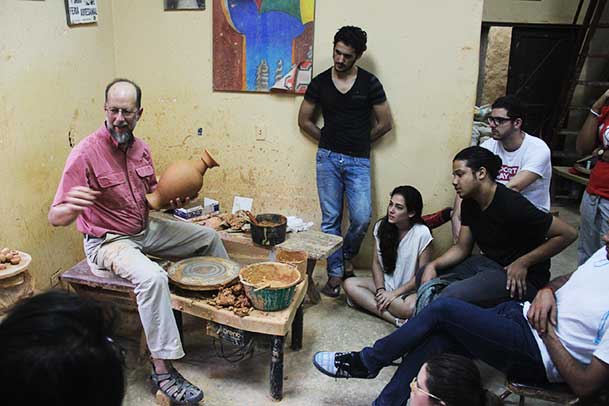by Kirk Butts
At first glance, finding a connection between a potter’s wheel and a college degree seems like a futile effort. It might even be considered a “stretch.” Take a moment though, and look a bit closer. Throwing a pot is hard work. It takes focus, ambition, and, most importantly, imagination. The artist must have a goal in mind, and must follow that goal to the end, even if it changes and evolves along the way. Sometimes, it is necessary to start over and begin again. When you think about pottery in this context, each action echoes the efforts it takes to earn a degree.
And with that, a connection is made.
For Mark Gordon, encouraging his students to make such connections on their own, through a combination of visual learning and critical thinking, is what makes his job such a gratifying experience.
“When a History of Clay student discovers a historical connection, or a student in Political and Social Comment Art makes a well-argued point using cartoons, or when a ceramics student surprises me with a creative solution to a project guideline, it gives me a glimpse of the joy that teaching at Barton brings,” shares Gordon, an associate professor of art at the College.
As an artist and educator at Barton, Gordon’s passion for molding students is as deep as his love for molding clay. The Rochester, N.Y., native has taught at the College since 1999. A prolific and internationally recognized ceramics artist, his works span the spectrum of size, shape, and even style. From traditional wheelthrown vessels to massive, room-filling installations built with a variety of materials, his art is as diverse as the students who fill his classrooms and studio.
“I would say that my inspiration is often derived from an eclectic mix – nature and plant growth, animal skeletons, machinery, scrap yard treasures, and international travel,” he explains in his artist’s statement. “I see artwork as a melding of idea and action, of inspiration and impulse.”
Gordon guides his students, helping them develop unique ideas and inspirations of their own. After all, learning is like art – full of complexity, depth, and variation.
“When a student’s interests extend to connect science, mathematics, social studies, and reading, with the traditional realm of visual art,” he says, “the opportunity for guided cross-disciplinary research helps them develop a deeper understanding of all subjects. As we say at Barton College, engaged learning leads to effective integral education.”
Thanks to immersive courses that are anything but traditional, Gordon emboldens his students to escape their comfort zones and “think outside the box.” And, this Barton professor certainly practices what he teaches. Gordon has traveled across the country and around the world, constantly learning firsthand methods of indigenous claymaking, and sharing his vast knowledge at more than 100 lectures and workshops. Fluent in Spanish for more than 30 years, he has made many trips to Latin America. This past summer, he led an educational leadership tour of Cuba.
These multifaceted and multicultural experiences make Gordon an essential builder of the Barton Experience. Each spring, the College bids farewell to an annual class of graduates who have developed a vision of competing successfully throughout the world, because of their own unique Barton Experience. But, before they can venture out into that big world, they must first discover the skills and craft the tools necessary to succeed.
“My students learn not only clay-working techniques, but also develop problem-solving abilities to utilize throughout life,” Gordon says. “At Barton, it is essential to help enable each student to confront uncertainty with strength of character. Answers don’t always come easily. Solutions require imagination, aesthetics, and intellect. Sometimes, the best thing an art student who is struggling with a project can hear? ‘It’s good for you.’”


